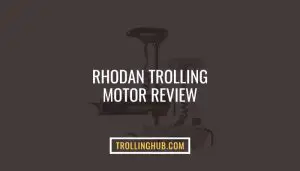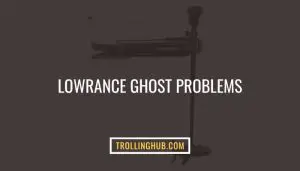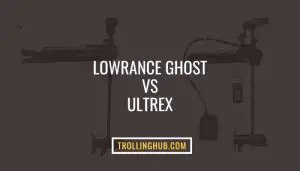Trolling for trout is interesting if you can go through the right ways. Considering some essential factors, you can make precise trolling. In that case, the best timing, lure types, location, temperature, lure’s food types, and many other factors are important. Although trolling for trout is so popular in terms of its high efficiency in covering large water surfaces, there are some beneficial techniques to follow.
And in this article, we’ll introduce you to the 10 best fishing techniques to help you troll perfectly. So, stay tuned if you want to utilize your time trolling for trout precisely.
Trolling For Trout: 10 Effective Techniques To Try
Following proper techniques, trolling can be easier, and you can catch more fish with less time investment. If you follow our tips and tricks below, you can fish even when the trout are in deep water. So, let’s explore the golden techniques-
- Choose the Right Type of Trolling Motors
Professionals use two trolling motors in large and small sizes. But, using one motor is also alright. If you use one, ensure a small gasoline trolling motor from 2 to 5 HP to handle the low speed and run the boat safely.
- Choose the Place Based on the Seasons
Next, you should consider the season because not all places are perfect in all seasons for trout. Trouts move from place to place depending on seasons and water temperature. Selecting the potential place, based on season and temperature, will be crucial.
- Don’t Stick on the Same Speed Level
The standard speed for trolling trout commonly varies from 1.5 MPH to 2.0 MPH. Thus, there’s nothing like you stuck on the same speed level. Remember, the trouts change their behavior from time to time. Therefore, change your speed level by focusing on the byte style of the trouts. For example, slow down the speed if the byte is slow. And vice versa. Also, you should go through a slow speed if trolling in the cold water.
- Stagger the Fishing Lines Widely
Trolling with more fishing lines allows for catching more trout. But you’ve to set the lines precisely. In this case, maintaining the distance is obvious. If you take 5 to 10 lines, set them widely to cover a wide water area. It will ensure a good move for more fish.
- Avoid Trolling with Straight Lines
For trout, zigzag fishing lines are more productive than straight lines. It makes trouts confident to make their bite fearless. So, try avoiding straight lines while fishing for trout.
- Stagger the Fishing Lines into Different Depth
Trout make the school according to their size. So here, staggering the fishing lines at different depth levels will increase the chance of catching more trout.
- Troll Crosscurrent
Trolling with or against the current will take you away from the trouts. But, trolling crosscurrent will ensure a perfect trolling for trout as trouts usually swim into the strong current.
- Choose Sunset or Daybreak
Usually, trout get deeper into the water at the sun’s rising time or if the sun is on the top of your head. It’s because the temperature at that time starts increasing. In that case, choose the weather that isn’t that shiny or bright and appears with low light. The comfortable temperature for trout is 34°. So, this weather temperature will help you catch more trout.
In general, trout can swim from 55° to 65°. But, as the temperature increases, it will be tough to target them.
- Troll in Still Water with Abundant Foods
Choosing still water conditions with food availability is high-priced for trolling for trout. Some narrow water areas are available with plenty of insects or baitfish, which are the ideal foods for trout. Select these types of areas to find more trouts with ease.
- Use Drift Bag
Using a drift bag is optional and it requires for those who aren’t confident in catching trout. Use a drift bag if you think it’s tough to slow your trolling motor and catch finicky trout. It will easier your job.
Trolling For Trout Without Downriggers
A downrigger is the top preferred option, though; no worries if you haven’t any downriggers. We’ll introduce you to 3 more options for trolling the large trout fish without a downrigger. Here these options are-
- Flat Lining
One of the least complicated trout trolling tips is the flat-lining method. This method is ideal for trolling for trout kayaks. This method allows you to troll from any boat that requires no costly or special gear. This option is perfect for shallow depths on the small water surface. All you need to do is to –
- Attach the diving lure
- Ensure the fishing lines are around 25 to 50 ft far
- Planner Boards
For smaller boats, this method can be a better option. Using this method, you can cover a large area for trolling. This is how you can use planner boards-
- Attach the cable (from 25 to 20 feet) and planer board.
- And throw them into the water.
- Take the drag set and place the lure in the water.
- Attach the fishing line, cables, and release lines.
- And throw them into the water.
- Lead Core Line
The flat-lining and the lead core line method are almost the same. The only difference is that this lead core line will allow you to fish in the deep water due to its weighted lines. The core lines, in most cases, come with 10-yard increments that assist them in sinking into 5 ft deeper with each of the 10 yards. Here’s how you can allow this process-
- Spool an accurate length of the lead line.
- Reel the thicker lead line
- Attach monofilament
- Deploy off the side of the boat in different depth levels and distances.
- You can merge it with the planner board if you want widespread coverage.
Trolling For Trout with Downriggers
This method is one of the excellent ways to troll with a downrigger for trout, and this system will help you catch fish faster in less time. You can easily detect the bites while using a downrigger. Despite its high effectiveness, casual anglers cannot use this method due to its high cost. Also, there are some other reasons, like the operating system of the downrigger is critical. However, once you get used to this amazing method, you can continue doing it hassle-free.
Ways to Use Downrigger
- Throw the lure far distance when you’re at a low speed
- Attach the quick-release line and fishing line
- Lower the weight
- Reel in sufficient line
Slow Trolling for Trout
You know the trolling speed from 1.5 to 2 MPH is ideal for trout. But, choose the cold water if you want to lower the speed. Slow speeds work well in the winter because the water condition remains cold.
In this case, your precise speed level will be 1.5 MPH with an s-pattern trolling style. This method will help you increase the speed level of the outside rod but decrease the inside rod’s speed. You can catch more trout in the cold water at this speed level.
Deep Water Trolling For Trout
It’s common to get deep water surfaces because of different holes. When the water surface is deep, you should follow some techniques. There are some beneficial steps to trolling for trout in deep water. And it will be easier to fish in deep water following these steps. Let’s check out how-
- Start the drift quicker.
- Add some additional weight.
- Switch to the streamer
- Dangle rather than casting
- Go with the attractor
Trolling For Brown Trout
These species are also named German brown trout. Usually, brown trout come in various types, for example, Salmonidae, Loch Leven, etc. So, when you troll for brown trout, you should troll according to their nature. Here’s how you can troll for brown trout-
How to Troll for Brown Trout
- Predict the Weather
Predicting the weather condition before you go trolling for brown trout is a must-do job. Some places, like East Lake, can be attacked by storms or snow anytime. In that case, checking out the weather condition will save you from unwanted situations.
- Go for the Right-Time
The best time for brown trout is from mid-June to late September. During that time, you can catch more fish. Remember, brown trout start moving into the shallower water by early fall.
- Focus on Your Speed
You can ensure a good fishing possibility if you can run 150 to 200 ft behind your fishing boat at 2 MPH. Keep your braided mainline with around 20 or 30 pounds. Also, the fluorocarbon leader or the monofilament should be 10 lbs in their weight.
- Use Downrigger
Using a downrigger for brown trout will be a good option. Downriggers are amazing if you want to fish in deep water up to 50 ft. But, using a downrigger is a bit costly. So, if you cannot afford it, go for the leaded line with 10 ft of leader.
- Attach the Mooching Sinker
Attach a mooching sinker with at least 2 ounces of weight in the plug. And it will allow getting down the lure in the accurate zone considering brown trout. If the weight is 4 ounces, it will be great. Attaching mooching sinker will help your empire lure action.
Trout Trolling Setup: 3 Best Setting Procedures
You should use the proper rigs to succeed in trolling for trout. Using an adequate rig will help you fish accurately. So, let’s know about the 3 most essential setting procedures-.
- Rig with Inline Weight
This setting is called the easiest way to fish trout. With its inline weight, the trolling rig works well in small water levels like ponds and lakes. You can set up the rig with its inline weight trouble-free. Check out the below steps-
- First, tie the main line with the inline and ensure the weight of that line varies from ¼ to 1 oz. If the weight hasn’t swiveled yet, tie a snap-swivel with the main line. And attach it to the total weight.
- We recommend you keep at least a swivel in your setup because the line can be twisted up sometimes. And having an additional swivel will help you overcome this situation.
- Now attach the fluorocarbon leader with a minimum of 2 to 4 ft long inline weight.
- Tie the lure to the leader’s end.
- Use a spinner if possible to make your trolling smoother.
- 3-Way Rig Setup
Tie your main line and the 3-way swivel in this setting method. And attach a 1-ft dropper line to the other side of the swivel. Now, tie a dropper line with a 2 oz weight maximum. Ensure that the weight of the dropper line is half compared to the weight of the main line.
- Flasher Rig Setting
This setting is perfect for attracting trout from a big distance. Here’s how you can set the flasher rig-
- Take the main line and thread a snap swivel on it.
- Now tie the main line using a barrel swivel
- Add 2 oz maximum weight to the snap swivel
- Tie a 2 ft leader to the swivel
- Tie the end of the leader with the flasher.
- Now tie the leader 20 inches to the flasher and then to your lure.
3 Best Trout Trolling Lures
Trolling isn’t that easy, especially when it’s about trout because of the trout’s uncertainty. If you find plenty of trout today, you might not get even a single one tomorrow. And this is where you should think about the trolling lure. Not all the lures are designed to make high performance.
In this case, we can recommend 3 top trolling lures considering their features, quality, functionality, and longevity. Take a quick look at the given lures below-
- PROBEROS Fishing Lures for Trout, Minnows, and Bass

When you want to get your lure for multi-purpose use, the Proberos fishing lure will be the best fit. It’s one of the top gear for fishing, not only lure but for bass, minnows, and many more. It has advanced features, including a fishing hook, lure eyes, simulated body, and rings. These amazing features will help you catch more fish in less time.
Pros
- It delivers a good balance
- Fit for any water surface
- Fish-attracting leaser included
- Reusable and odor-free
Cons
- No significant drawbacks found
- TOPFORT 187/230pcs Fishing Luer for Trout

To make your fishing task easier and more interesting, you can use the Topfort fishing lure for trout. It is the most cost-effective and high-quality fishing product. You’ll get it available with 20 pieces of spinners and a well-designed portable bag. Also, it comes with a stainless-steel buckle to allow you to hang it up on your backpack or the belt. As a result, it will be convenient and safe to use.
Since this lure is available with 20 pieces, you can choose the perfect one considering your situation. The Topfort is an ideal fishing gear for both saltwater and freshwater.
Pros
- Can attract the trout efficiently
- A free carry bag is included
- Easy to set
- Safe to use
Cons
- Heavyweight
- LUCKYMEOW Fishing Lure

One of the most colorful fishing lures is the Luckymeow fishing lure. This item is made of metal to offer longevity. It won’t break or kink so easily. The 5 different colors of this lure will ensure a super reflection to make it easier to catch more fish.
You’ll find it suitable for trout, pike, bass, minnows, and many other species. The bait can search in various water layers based on your fishing operation. Whether you fish in a lake, river, or seawater, the Luckymeow is perfect for all water types.
Pros
- Perfect gear for carnivorous fish
- Designed with an exclusive streamlined shape for more agile
- long-lasting
Cons
- Heavyweight
Best Time to Troll for Trout
What can be your best time for trolling depends on several factors. But, if you want to get a specific answer to the question of what month is best for trout fishing? Or What time is trout most active? Then the answer would be spring.
You might wonder why spring and why not winter. Well, spring can offer an excellent combination of temperature and food availability. The springtime creates a wonderful surrounding to troll for trout. You can make your prime target with your files, baits, and lures when the trout are busy having their food.
FAQs
If you go for lake trout trolling, the speed level should be less than 2 MPH. But, depending on your trout techniques and the lure condition, the speed can go up or down.
Professionals suggest having trout leaders from 12 to 18 inches in length. But, many anglers prefer to get the trout leader 5 or 6 inches long.
If the temperature is approximately 65°, it will be tough to get trout.
The rainbow trout like to have nymphs, minnows, worms, colored marshmallows, salmon eggs, and kernel corn for bait. Try using any one of these foods while fishing.
If you suspend the bait and fish off the bottom, the bobber can be an ideal solution for more trout. Vice versa.
Trout usually sit on the bottom side of the river, looking upstream to see whether food is coming down. So, if you can spot them properly, you won’t be troubled to fish.
You can choose the color gradually from blue, red, and green. Remember, the red color seems brighter to the trout. However, it turns black soon as the distance increases.
Well, you cannot compare these two fishing lines with each other because of their separate functionalities. The Mono fishing line is the best live bait for trolling and fishing.
Braided line, on the other hand, is an excellent gear for jigging, casting plugs, lures, fishing kelp, and bottom fishing. So, choose the right one considering your fishing requirements.
To Wrap Up
Trolling for trout fish is an art, but if you want to master your skill for trout fishing, you must research all the best techniques. Although some anglers overlook trolling when it’s about trout, trolling is the effective way.
We’ve discussed all the essential factors in detail in our article. Don’t miss any point in experiencing an excellent trolling fishing setup for trout.




